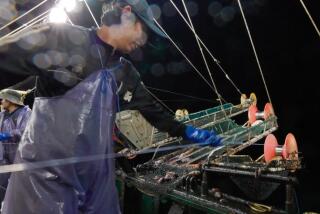Dinner’s free -- but there’s a catch
- Share via
Isla Cavada, Panama — We’re RUNning low on food, and the nearest supermercado is 200 miles away. But the shell-strewn sands and crisp, clear water here are too beautiful to leave. So there’s only one answer to the cruiser’s daily question of what’s for dinner.
“Scallops again?” It’s the only thing I have to whine about since ditching the 9-to-5 to sail a 37-foot sloop till the money runs out.
The promise of fresh scallops comes at a price in Los Angeles eateries, but here at anchor in the Secas Islands, the shellfish are free for the taking. You just have to work for them. All day.
A sailor’s scallop dinner begins at 9 a.m. The attire: swimsuit, fins and a snorkel. With the morning’s low tide, we dinghy to nearby reefs, drop anchor and begin the hunt.
The scallop shells here are chevrons: Think Shell Oil. But they aren’t as easy to spot from the surface as one would think. The fist-size shells aren’t smooth and pink; they are covered in barnacles and brown moss and nestled among rocky crevices 6 to 16 feet underwater.
There the scallops lie in wait for passing food, their shells open about an inch. As soon as you touch one, they snap closed; that’s how you know you’ve got a live one. Now the trick is prying it off the rocks before you run out of breath.
With gloves, a small pry bar and our lungs full of air, we go to work. Some scallops put up a tough fight.
At times the current fights us, tossing our legs one way, then the other, while we cling to a scallop with both hands, pulling, tugging, cursing.
For dinner for two, we need about 40 scallops, which means the hunt takes about an hour. Now the real work begins: the cleaning process.
We scavenge a quick lunch from our dwindling supplies while we wait for the scallops to reopen in a shallow bucket of seawater in the dinghy. There’s no use showering yet; we’re about to get messy.
We begin by inserting a knife into an open scallop, which quickly clamps shut. But it’s too late. With the knife inside, we slice the scallop in half and pry open the shell, its juices dripping onto our bare feet.
Whoever first figured out there’s a taste treat in these things must have been a genius. Or very hungry. Inside each iridescent half sits a black and white gooey blob inhabited by at least one invader: inch-long creatures, lobster aberrations devoid of color.
With a squeal, those are quickly flicked overboard. Then the black slime is attacked. Fingernails are the best weapon. A final rinse leaves behind a quarter-size pearl of juicy meat, which we slice off and place in a bowl of fresh water.
About two hours later, we’re fried, our fingers aching from the repetition and the shells’ rough exteriors, our skin burning from the tropical sun. But the work is done, and dinner is only an hour away. While the scallops marinate, we shower with rainwater and crack open a beer.
A quick butter, basil and garlic saute takes five minutes. Ten minutes later, I’m asking the other daily question: What’s for dessert?
All evidence of our day’s work is gone, except the ever-growing scallop shell graveyard glowing 30 feet below our sailboat. The water here is too clear, the area too beautiful. We can’t bring ourselves to leave tomorrow either.
To be continued ....
More to Read
Sign up for The Wild
We’ll help you find the best places to hike, bike and run, as well as the perfect silent spots for meditation and yoga.
You may occasionally receive promotional content from the Los Angeles Times.






